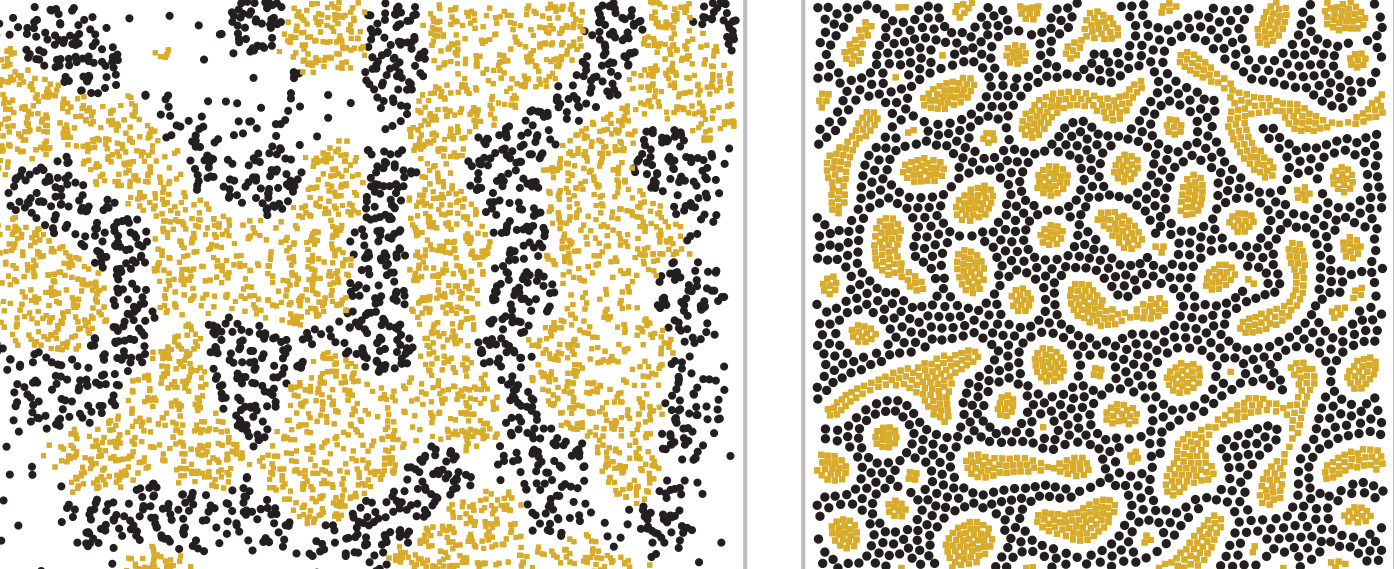PROVIDENCE, R.I. [Brown University] — A mathematical model developed by Brown University researchers is shedding new light on how zebrafish get their iconic stripes. The model helps to demonstrate how two dynamic processes—the movement of pigment cells across the skin, and the birth and death of cells as the fish grows—combine to keep zebrafish stripes in line.
The model is described in the Journal of the Royal Society Interface.
Zebrafish have become quite a popular model organism for biology researchers over the past few decades. The small freshwater fish begin life as transparent embryos and develop in just a few months to full size, giving scientists the chance to watch their development in detail. The emergence of their namesake stripes of dark blue and bright yellow has been the subject of much research. The stripes have been shown to be the result of interplay between three types of pigment cells: black melanophores, yellow xanthophores, and silvery iridophores.
“The stripe pattern forms dynamically as the fish develops,” said Alexandria Volkening, a graduate student and Brown’s Division of Applied Mathematics and the lead author on the new paper. “It’s not like these pigment cells are filling out some kind of prepattern that’s already there. It’s the interactions of the cells over time that causes the patterns to form. We wanted to build a model that simulates this based as much as possible on what’s known about the biology.”
The model Volkening developed treats cells as individual agents, behaving according to a set of rules derived from experiments. It directly incorporates two types of cells: the black melanophores and the yellow xanthophores. The effects of the third cell type, the iridophores, are implicit in the behavior of the other two cells, though the iridophores themselves are not physically included in the model.
The model starts with melanophores and xanthophores arranged in a way that mimics the arrangement of cells in fish just a few weeks old. The model domain then grows in a way that approximates the growth of the fish. As the domain grows, new cells are added that mimic the stem cells from which pigments are derived in actual fish. The stem cells take cues on which type of cell to become from existing pigment cells. Those cues come both from cells in the immediate vicinity, and from cells further away. Experiments in actual fish have suggested that both short- and long-distance communication is important. In the model, if a new stem cell is surrounded by black cells and the adjacent developing stripe regions are yellow, it has a much greater chance of becoming a dark cell itself. The same goes for yellow cells. Cell death is controlled by similar mechanism. A black cell surrounded on all sides by light ones or without sufficient yellow cells in adjacent stripe regions has a much higher probability of dying.
Experiments have shown that pigment cells also have the ability to move short distances across the fish’s skin, and the model captures that dynamic as well. The pigments are thought to move according to cues communicated from surrounding cells. In the model, all of the cells repel each other, but different cell types have a stronger repulsion than like cells. The movement cues are gathered from the cells immediately surrounding a pigment cell.

Cell movement as well as the birth and death of cells are critical to stripe formation. Restricting movement produces stripes that point in no particular direction (left) while restricting cell birth and death creates spots (right).
Using these rules over the normal growth period of an actual fish, model was able to successfully recreate the development of stripes as seen in experiments. It was also able to recreate the results of a variety of experiments biologists have done to perturb stripe formation. For example, scientists have ablated pigment cells early in a fish’s development to see how it would affect stripe development. Those experiments showed that when cells are knocked out, the fish form oblong spots rather then stripes as they continue to develop. The model was able to recreate those effects.
Once they had a model that could reconstruct actual experiments, the researchers could test how different cellular dynamics influence stripe growth.
“One thing that’s not clear is the role of birth and death versus movement. Do you need both or just one?” said Bjorn Sandstede, chair of Brown’s Division of Applied Mathematics and a co-author of the paper. “What we can do in the model is turn off one of the two and see what we get.”
With movement turned off, the model showed that cells formed oblong blobs with no particular orientation. With birth and death turned off, like cells formed tightly packed spots rather than stripes. Taken together, the results help to confirm the interdependent dynamics of the two processes in the development of the stripe pattern.
Sandstede says that simulations like these are important because they offer a window into how complex patterns and structures form dynamically in nature. “If you look at any kind of organism, they start with oocytes, which are roundish structures with little spatial differentiation at all, and you end up with organisms like us that have a complex spatial structure,” he said. “I think it’s important to try to understand how spatial differentiation occurs. Zebrafish and their stripes are a good model to do that because you can identify the different cells and what they’re doing in the process.”
Volkening says she plans to continue to refine the model to better capture the effects of iridophores that were not directly included in the current model. She hopes the model can serve as a guide for future experiments in actual fish.
“One of the benefits of the models is that we can do this in six minutes,” she said. “It takes weeks to grow the fish,” Volkening said.

